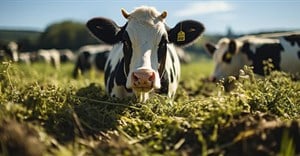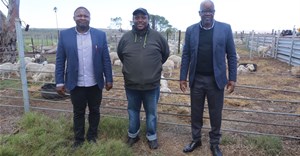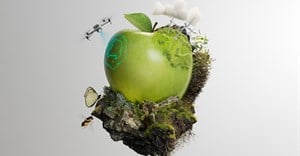Trending



 Sabre EMEA 2024 Awards: Razor PR, Retroviral top SA agenciesDanette Breitenbach
Sabre EMEA 2024 Awards: Razor PR, Retroviral top SA agenciesDanette Breitenbach Clothing brand Curve Gear opens new store in Tygervalley CentreLindsey Schutters
Clothing brand Curve Gear opens new store in Tygervalley CentreLindsey Schutters
Elections 2024
Jobs
- Account Sales Agent Nelspruit
- Area Sales Consultant Bushbuckridge
- Financial Clerk George
- Creditors Controller George
- Outbound Sales Associate Nelspruit
- Promoters Bushbuckridge
- Admin and Finance Coordinator Cape Town
- Mid-Level Visual Designer Cape Town
- General Sales Worker Bushbuckridge
- Field Sales Representative Nelspruit
SA agribusiness confidence rebounds in Q4

A level above the neutral 50-point mark implies that agribusinesses are optimistic about operating conditions in the country. The results reflect the favourable outlook about the 2021/22 production season. The higher commodity prices, combined with the excellent weather outlook on the back of a La Niña event, are conducive to agricultural activities and could help farmers offset the higher input costs that farmers incurred at the start of the season. This survey was conducted over the last two weeks of November and covered agribusinesses operating in all agricultural subsectors across South Africa.
Figure 1: Agbiz/IDC Agribusiness Confidence Index

Discussion of the subindices
• The ACI comprises ten subindices and all improved from the third quarter of this year. The turnover and the net operating income subindices increased by 10 and 1 points from the third quarter to 92 and 85, respectively. This reflects improved farm incomes on the back of a large harvest in the 2020/21 season across the field crops and horticulture products, along with generally higher commodity prices, especially for grains and oilseeds.
The one major challenge that most respondents highlighted is the higher input costs, which is reducing profit margins of most farming business. Still, the favourable production outlook for the 2021/22 season and persistently higher commodity prices suggest that most farming businesses could remain profitable.
• After falling by 8 points in the third quarter, the market share of the agribusinesses subindex improved by 6 points to 77 in the last quarter. The financial institutions and the agribusinesses in horticulture and winter crops were amongst the respondents that signalled an improvement in the market share subindex. At the same time, the rest of the respondents maintained a broadly unchanged view from the third quarter.
• The employment subindex improved by 2 points from the third quarter to 62. This is reflective of the general improvement in agricultural activity on the back of favourable rainfall and farmers having signalled a 5% y/y improvement in summer crop plantings this year, and general progressive improvement in horticulture production.
• Surprisingly, the capital investments subindex jumped by 22 points to 79, which is the highest level since the second quarter of 2014. Some respondents attributed the improvement in this segment to consolidation in the sector and spending on movable assets, which is reflected in recent robust tractors and combined harvesters sales.
For example, South Africa's total tractor sales for the first 10 months of this year are at 6,238 units, up by 25% year-on-year. The combined harvesters' sales increased by 37% year-on-year over the same period, with 242 units sold.
• The subindex measuring the volume of exports sentiment rebounded by 6 points to levels seen in the second quarter of this year, which is 79. The sizable harvest from the field crops and horticulture, combined with cooperation amongst the logistics stakeholders and Transnet in facilitating exports, has helped sustain exports at fairly higher levels. This also reflects some normalisation in export activity after the serious challenges Transnet experienced in Q3.
• Following a sharp decline of 30 points in the third quarter of the year, the economic conditions subindex improved by 25 points to 73. This optimism was broad-based across most respondents and reflective of the positive economic prospects by key institutions such as the IMF and the SA Reserve Bank (SARB). The SARB currently forecasts South Africa's 2021 economic growth at 5,2% year-on-year (from a -6.4% contraction in 2020, primarily because of the covid-19 shock).
• Expectedly, the general agricultural conditions subindex jumped by 18 points from the third quarter to 88. This is reflective of the favourable production conditions across the country. The summer crop plantings are underway, and most regions of South Africa have been receiving favourable La Niña induced rainfall since the start of October.
• The debtor provision for bad debt and financing costs subindices are interpreted differently from the indices mentioned above. A decline is viewed as a favourable development, while an uptick is not a desirable outcome as it shows that agribusinesses are financially constrained.
In the last quarter of 2021, the indices for debtor provision for bad debt and financing costs fell by 14 and 9 points to 54 and 46, respectively. This is favourable and reflective of the relatively lower interest rates, notwithstanding the recent increase in the repo rate. Moreover, this also reflects the improvement in farmers' finances, enabling them to service their debts.
The Agbiz/IDC ACI's fourth-quarter results present a picture of a sector poised for another year of positive growth if weather conditions remain favourable and the logistics remain fairly operational for export markets.
"We were concerned that the higher input costs would discourage planting in some areas of the country, but all the high-frequency data point to the opposite. Farmers are boosting plantings and taking advantage of the favourable weather conditions and attractive commodity prices. All else being equal, we are heading for another year of solid growth in South Africa's agricultural sector," says Wandile Sihlobo, Agbiz chief economist.








